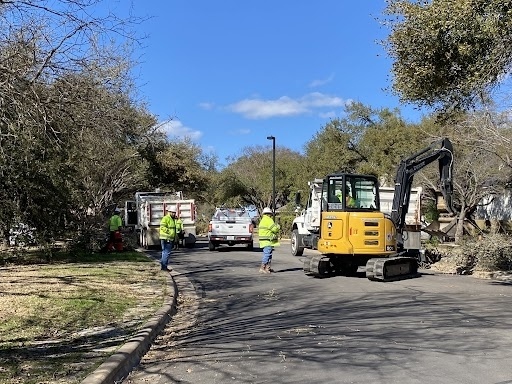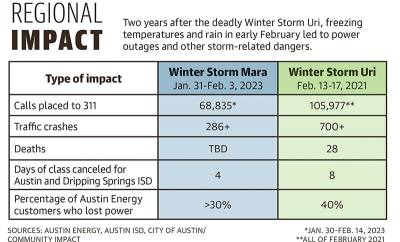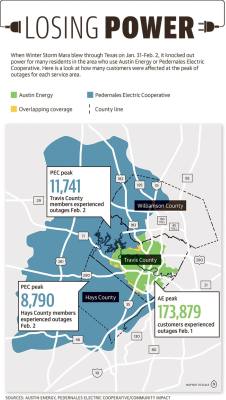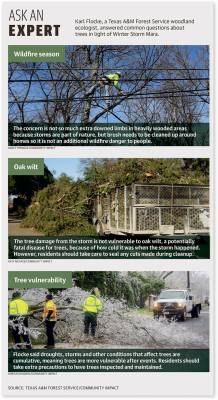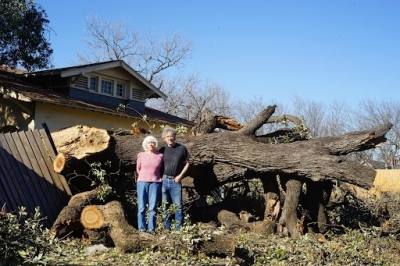“We ran outside because we feared [a tree] had fallen on the house,” Carrlyn Miller said. “In fact, that brought people from across the street.”
Winter Storm Mara, which hit the Austin area starting Jan. 31 with freezing temperatures and half an inch or more of accumulated ice, caused widespread destruction and power outages, including knocking out a heritage oak tree in a neighboring church’s yard into the Millers’ fence. The city of Austin said 36,000 dump trucks of debris has already been picked up as of Feb. 21.
The ice coated power lines and trees, knocking out electricity to at least 170,000 Austin Energy customers and thousands of Pedernales Electric Cooperative members. The icy conditions also led to hundreds of car crashes in Central Texas and a boil-water notice in western Travis County.
"This storm is ungodly," said Elton Richards, Austin Energy vice president of field operations. "I've never seen it in my life ... I worked in the northern part of Illinois, never saw this level of devastation."
Frustrations from community and City Council members over AE’s communications, such as promising then walking back a timeline for total power restoration, and Austin’s storm response have built up. On Feb. 15, City Council fired City Manager Spencer Cronk in part for his response to the storm.
Weathering the storm
Temperatures dropped below freezing Jan. 30 and hovered near 32 degrees until Feb. 3, according to National Weather Service data, and it rained over the next few days.
More than half an inch of ice is considered significant for any part of the county, said Mack Morris, an Austin/San Antonio NWS meteorologist.
AE General Manager Jackie Sargent called the storm a “historic extreme.” Over 30% of AE customers lost power, largely due to debris on power lines. The number of customers refers to a single meter. A customer represents 2.5 people on average, per industry standards.
A PEC representative said the majority of the outages were caused by ice accumulation on lines and damages from falling sheets of ice. PEC officials said Winter Storm Mara caused damage similar to what is seen with a hurricane or tornado.
Soon after outages began, Sargent and other AE officials began fielding questions about vegetation management—or the utility’s responsibility to trim trees around power lines.
In May 2019, Austin Council approved widening the tree trimming around power lines to 8 feet for fast-growing trees and 4 feet for slow-growing trees. At the time, AE officials warned the trees were overgrown in many areas.
AE has maintained better vegetation management would not have made a huge difference due to the severity of the storm.
Michael Webber, a professor of mechanical engineering at The University of Texas and a former AE commissioner, said he believes overall the city-owned utility performed relatively well under the circumstances.
Webber agreed a more aggressive trimming approach likely would not have made a significant difference in this year’s weather event due to heavy ice accumulation affecting trees and branches well outside the bounds of the vegetation program.
However, council voted Feb. 9 to call for an audit into tree management.
While moving power lines underground could run the city billions of dollars, Webber said it is something that should be seriously explored.
“The undergrounding is more expensive upfront; it is slower to bring back if it goes down; it’s harder to do repairs underground than above ground. But it’s more robust; it fails less often,” he said.
After the action
On Feb. 2, Sargent estimated all outages would be fixed by Feb. 3 before announcing there was no timeline for repairs just hours later. On Feb. 5, officials said “nearly all” outages would be fixed by Feb. 12.
The storm and its aftermath raised questions about AE’s communications system in emergencies, including direct customer notifications and the capacity of its virtual outage map.
Following a Feb. 7 briefing, Austin City Council further questioned AE on Feb. 21, after press time, about its storm response. Mayor Kirk Watson and other leaders have also called for AE’s internal after-action report to be released quickly.
Sunset Valley resident Michelle Roberts said after the deadly winter storm in February 2021, she should have planned better, but she thought this storm would be different.
“Everyone kept saying the grid would hold this time, so I wasn’t that worried,” Roberts said. “Well, then my power went out at 3 a.m. on [Feb. 1] morning and didn’t come back on until [Feb. 2] afternoon.”
Like Roberts, many are wondering why the city was hit so hard by the disaster just two years after 28 people died in Travis County; all of Austin was under a weeklong boil-water notice; and 40% of AE customers lost power.
District 10 Council Member Alison Alter said many issues tracked during this year’s storm mirror problems with the city residents may have seen during Winter Storm Uri two years ago and last year’s citywide boil-water incident.
The city of Austin released after-action reports following those events, highlighting flaws with communication and disaster management. Later, it issued a report saying Austin’s weather-related shelters were mismanaged, potentially leading to residents suffering.
“There’s so many places where we heard these challenges; we talked about them; they were raised,” Alter said. “We have got to figure out how we learn the lessons.”
Cleaning up
On Feb. 3, Austin, Dripping Springs, Hays and Travis Counties declared local disasters, which opens access to state and federal resources.
Most cleanup is expected to wrap up in February, but some work could stretch into April, according to the Austin Resource Recovery department. Residents can place trees and branches on the curb for pickup.
The Millers did not lose power, which was their biggest fear during the storm, just two years after statewide power failures during Winter Storm Uri. However, they have received conflicting information on what the city will do to help with the tree, which is so big one employee said it would take a crane to move. However, they are thankful the tree did not cause more damage.
“If it had fallen on the house, it might have killed us,” Lee Miller said. “It certainly would have destroyed the house.”
Amanda Cutshall contributed to this reporting.





